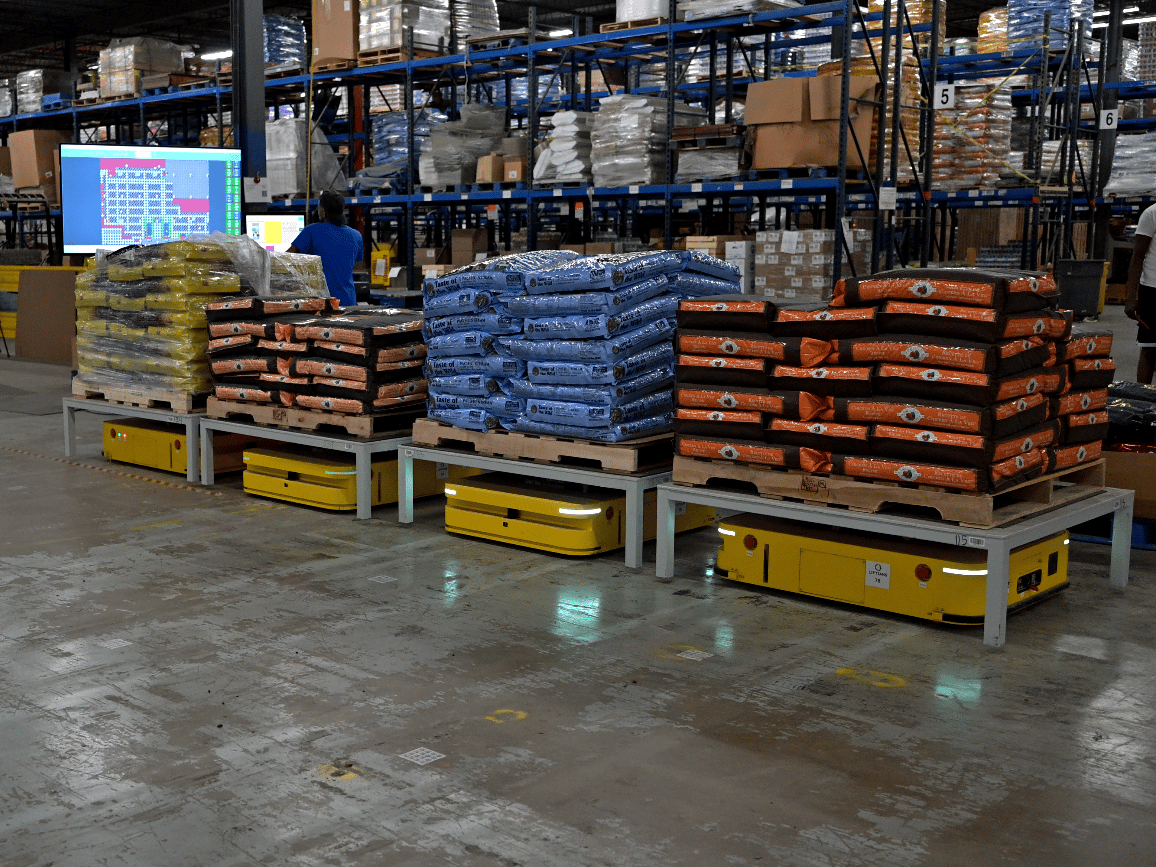Differences Between Various Warehouse Automation Solutions
Warehouse automation solutions come in different forms, each tailored to optimize specific aspects of warehouse operations. Here’s a detailed breakdown of the various types and their unique characteristics:
1. Automated Guided Vehicles (AGVs)
Function: AGVs are mobile robots that transport goods within a warehouse.
Navigation: They typically follow fixed paths guided by markers, wires, or magnetic strips on the floor.
Use Cases: Suitable for repetitive tasks such as transporting goods between different areas of a warehouse and delivering goods-to-people to optimize picking and replenishing processes.
Advantages: Reliable and precise for predefined routes, reducing labor costs and increasing efficiency.

Liftians AGVs delivering goods to picking station Photo by Liftians
2. Autonomous Mobile Robots (AMRs)
Function: AMRs are similar to AGVs but are more advanced in navigation and flexibility.
Navigation: Use sensors, cameras, and complex algorithms to navigate dynamically without fixed paths.
Use Cases: Ideal for dynamic environments where tasks and routes frequently change.
Advantages: Highly flexible, can adapt to changes in the warehouse layout and tasks.

Photo by Hyundai Motor Group AMRs on Unsplash
3. Automated Storage and Retrieval Systems (ASRS)
Function: ASRS systems automate the storage and retrieval of products.
Components: Include cranes, conveyors, carousels, and shuttles that move goods in and out of storage racks.
Use Cases: High-density storage areas requiring efficient space utilization and fast retrieval times.
Advantages: Maximizes storage space, improves picking accuracy, and reduces labor costs.

Automated Storage and Retrieval System from Tiero on Canva
4. Conveyor and Sortation Systems
Function: Use conveyor belts and sortation systems to move and sort items within the warehouse.
Components: Includes various types of conveyors (belt, roller, etc.) and sorters (tilt-tray, cross-belt, etc.).
Use Cases: Suitable for high-volume distribution centers needing efficient product sorting and transport.
Advantages: Increases throughput, reduces manual handling, and enhances operational efficiency.

Conveyor and sortation Photo by Homa Appliances on Unsplash
5. Robotic Picking Systems
Function: Use robotic arms and vision systems to pick and place items.
Technology: Often combined with AI and machine learning for identifying and handling items.
Use Cases: Ideal for e-commerce fulfillment centers with diverse product ranges and high order volumes.
Advantages: Increases picking speed and accuracy, reduces labor costs, and handles repetitive tasks.

Robotic arms picking goods from conveyor belt and placing onto AGVs Photo by @phonlamaiphoto
6. Warehouse Management Systems (WMS)
Function: Software platforms that manage and optimize warehouse operations.
Features: Inventory tracking, order management, labor management, and analytics.
Use Cases: Essential for managing complex warehouse operations and integrating various automation systems.
Advantages: Provides real-time data, enhances decision-making, and improves overall efficiency.
7. Internet of Things (IoT) in Warehouses
Function: Uses connected devices and sensors to collect and exchange data.
Applications: Monitoring equipment health, tracking inventory, and optimizing energy usage.
Use Cases: Warehouses looking to implement smart systems for better control and insights.
Advantages: Real-time monitoring, predictive maintenance, and improved operational visibility.
8. Drones
Function: Unmanned aerial vehicles used for inventory management and internal transportation.
Capabilities: Conduct cycle counts, inspect high shelves, and transport small items.
Use Cases: Large warehouses with high shelves and extensive inventory that require efficient stock-taking.
Advantages: Reduces manual inventory checks, improves accuracy, and speeds up stock-taking processes.

Delivery drone in warehouse by baranozdemir from Getty Images
9. Collaborative Robots (Cobots)
Function: Robots designed to work alongside human workers.
Safety: Equipped with safety features to ensure safe interaction with humans.
Use Cases: Suitable for tasks that require human-robot collaboration, such as picking and packing.
Advantages: Enhances productivity, reduces worker fatigue, and maintains flexibility.

Worker collaborating with Liftians AGVs to optimize picking Photo by Liftians
10. Pick-to-Light and Put-to-Light Systems

Picker waiting for bin’s indicator light after scanning product Photo by Liftians
Function: Uses lights and displays to guide workers to the correct locations for picking or putting items.
Technology: Integrated with WMS for real-time updates and accuracy.
Use Cases: Ideal for environments with high-speed picking and sorting requirements.
Advantages: Increases picking accuracy, speeds up the picking process, and reduces training time.
Summary
Each warehouse automation solution is designed to address specific operational needs and challenges. AGVs and AMRs optimize material transport, ASRS and conveyor systems enhance storage and movement efficiency, robotic picking systems automate the picking process, WMS provides comprehensive management, IoT offers real-time monitoring, drones assist in inventory management, cobots facilitate human-robot collaboration, and pick-to-light systems improve picking accuracy. By understanding these differences, businesses can select the most suitable automation technologies to optimize their warehouse operations.

